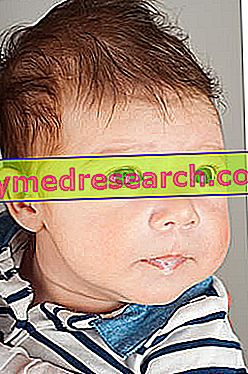Generality
The reflux of the newborn is a phenomenon that occurs in the first few months of life and that consists in the ascent to the esophagus of the food present in the gastric level (ie in the stomach).

If the reflux turns out to be a persistent problem and with serious repercussions on the infant (weight loss, recurrent crying, repulsion for food, violent vomiting and with traces of blood etc.), then at its origin there could be morbid conditions that require a specific treatment.
These conditions include: gastroesophageal reflux disease, esophagitis, allergic gastroenteritis and pyloric stenosis.
What is the reflux of the newborn?
The reflux of the newborn is a typical phenomenon of the first 12-14 months of life and that consists in the ascent, from the stomach to the esophagus, of the food ingested with a feed or a meal.
Marked sometimes by regurgitations to the mouth (with lots of small food emissions), it is a fairly common condition and only in rare cases a cause for apprehension and alarmism.
If the gastric juices also go up with food, we also speak of the baby's acid reflux, where the word acid refers to the acidity (low pH) of gastric juices.
Epidemiology
About 50% of children within the third month of life show reflux phenomena. However, only in a few of these, its occurrence is linked to a serious health problem.
Among children in the 10th month, the percentage of reflux cases drops to 5%.
Although it happens very rarely, it is possible that some children continue to suffer reflux even up to the 18th month.
Causes
In general, newborn reflux occurs due to a combination of factors .
Surely the most important and influential reason is the fact that the cardias of newborn babies (and up to the 12th-18th month) is still immature and not very functional.
The cardia, or lower esophageal sphincter, is the valve located between the esophagus and stomach, which regulates the unidirectional passage of food between these two behaviors (the correct sense is: esophagus → stomach).
Secondly, they can affect the appearance of reflux:
- The liquid diet (milk in particular), typical of the neonatal age.
- The formation of bubbles in the stomach that "push" the food present towards the esophagus.
- Excessive speed in drinking by the child.
- Excessive amount of food given to the newborn.
Cardias open only when a person swallows food, that is, when he swallows. At all other times of the day it is closed, so that it is impossible for the contents of the stomach (whether it be food or gastric juices) to go up into the esophagus or higher.
WHEN THE REFLUX IS A SERIOUS PROBLEM
In a small number of cases, the reflux of the newborn is the consequence of some serious or problematic morbid conditions, such as:
- Allergic gastroenteritis .
The term gastroenteritis refers to an inflammation of the mucous membrane of the stomach and / or intestine. A gastroenteritis is defined as allergic, when the inflammatory process is subsequent to an abnormal reaction to a food present in the stomach; reaction generally characterized by: vomiting, diarrhea and skin rash.
In infants, or rather in children for whom milk is still the primary source of food, allergic gastroenteritis is usually due to an intolerance towards cow's milk proteins (or cow's milk), used instead of the maternal one.
- Gastroesophageal reflux disease .
We talk about gastroesophageal reflux disease when the rise of food and gastric juices in the stomach is a constant, not sporadic (NB: when it is a sporadic event, we only speak of gastroesophageal reflux).
In the case of newborns, gastroesophageal reflux disease is due to a marked immaturity of the cardia. This condition is often observed when the child: was born prematurely; he had a low birth weight; was born with a nervous and / or muscular disease, such as cerebral palsy; is allergic to cow's milk.
- Eosinophilic esophagitis .
It is the inflammation of the esophagus (in medicine, the suffix -ite following an organ indicates an inflammatory state) due to an allergic-type reaction (eosinophils are white blood cells also involved in allergic reactions).
Children suffering from this disorder have a high presence of eosinophils in the esophageal mucosa.
Although they do not yet have definite evidence, the researchers believe that the cause of the allergic reaction is a food to which one is intolerant.
- The obstruction or narrowing of a tract of esophagus or stomach (more precisely of the pyloric tract of the stomach) . It is a condition that is possible in children but very rare.
If the obstruction or narrowing resides between the stomach and small intestine, that is, at the level of the valve called pylorus, it is also referred to as pyloric stenosis. The presence of a pyloric stenosis prevents the complete passage of food from the stomach to the intestine, ie the complete gastric emptying.
Symptoms and Complications
Although it does not always occur, the most characteristic sign of newborn reflux is regurgitation to the mouth of the gastric contents.

OTHER SIGNS OF A POSSIBLE REFLUX
If the gastric contents do not rise up to the mouth, but stops at the throat or esophagus, a parent may suspect the presence of reflux episodes in the event of:
- Inappetence, or poor appetite often accompanied by a sense of repulsion for food.
- Lack of growth of your child or, in the worst cases, loss of body weight.
- Frequent plants, especially after meals and at night, when your child is lying down.
- Frequent irritability in the child.
- Frequent cough, even when the baby is not suffering from any form of cold.
WHEN TO REFER TO THE DOCTOR?
As mentioned several times, the reflux of the newborn is a condition that, in mild terms, occurs quite frequently, therefore it is to be considered an almost normal phenomenon.
If, however, the child manifests:
- Violent episodes of vomiting, or "projectile" vomiting
- Weight loss or loss of weight
- Regurgitations up to the mouth of yellow or green color
- Vomiting with traces of blood or with something reminiscent of coffee grounds (NB: the presence of blood is consequent to the irritation produced by gastric juices to the damage of the mucous membrane of the esophagus).
- Breathing difficulties
- Blood in the stool
- Vomiting from the age of 6 months
- Strong repulsion for food
it is advisable to contact your pediatrician immediately and request an appointment to learn more about the situation.
In fact, the aforementioned manifestations could be the signal of morbid states - such as gastroesophageal reflux disease, eosinophilic oesophagitis, pyloric stenosis, etc. - even at an advanced / severe stage.
COMPLICATIONS
In addition to a slowing of growth and respiratory problems, the reflux of the newborn would seem to be one of the causes that, in adolescent age, triggers gastroesophageal reflux disease in some individuals.
However, it is worth pointing out that researchers do not yet have precise proofs about this possibility.
Diagnosis
To understand the extent of the reflux (ie whether or not it is a serious problem), the pediatrician must subject the newborn to a thorough physical examination, during which he visits the child and questions his parents about the symptoms or signs noted up to that point moment.
If there are no particular problems (such as a drop in body weight, etc.), the diagnostic procedure can be considered already concluded: the child, in fact, is healthy and within a few months will no longer present any disorder.
If, on the contrary, the physical examination reveals the presence of complications, it becomes fundamental to carry out more in-depth diagnostic tests, including:
- Ultrasonography of the tract corresponding to the esophagus / stomach.
- Various laboratory tests.
- Monitoring of esophageal pH (or pH-metry ).
- An x-ray of the gastrointestinal tract (or " barium meal ").
- An endoscopy of the upper digestive tract .
ULTRASOUND
Ultrasound is a very popular diagnostic imaging test, as it is harmless and sufficiently comprehensive.
For its realization, an ultrasound probe is used which, resting on the patient's skin, allows the visualization of the organs and underlying tissues, thanks to images projected on a monitor appropriately connected.
The ultrasound of the gastroesophageal tract can clarify if the patient suffers from pyloric stenosis or other similar problems.
LABORATORY EXAMINATIONS
Laboratory tests consist in performing analyzes on urine and blood samples .
Their execution serves to identify some causes that can induce vomiting or weight loss. They are also useful for the purposes of a differential diagnosis, that is when evaluating possible conditions with symptoms similar to the suspected one.
MONITORING OF THE ESOPHAGEAL pH
Monitoring of esophageal pH, or pH-metry, is the measurement of acidity levels within the esophagus and stomach.
For its realization, it is necessary to insert a special tube, which is inserted into the nose and then led slowly to the two compartments of the aforementioned digestive system. At the end of the tube, a small sensor is installed (an electrode) capable of recording the level of acidity and bringing it back to an external device (to which it is obviously connected).
For adults, the pH-metry is not painful, but it is annoying when the doctor inserts the tube (for this an anesthetic is used); in newborns, it is difficult to establish what its execution causes, however it does not generally involve any complication.
Particularly useful in cases of suspected gastroesophageal reflux with acid character, the examination can last several hours (usually 24 hours) and requires hospitalization of the infant (for pH monitoring).
RADIOGRAPHY OF THE GASTROINTESTINAL TRACT
Radiography of the gastrointestinal tract can provide important information regarding the state of health of the internal walls of the stomach and intestine (initial part).
It is also called " barium meal " because, to improve the vision of the affected portions, the radiologist gives the patient a liquid containing barium sulfate (NB: the liquid is white and has a milky appearance).
The radiography of the gastrointestinal tract is particularly useful even when the presence of an obstruction between the stomach and the intestine (pyloric stenosis) is suspected.
ENDOSCOPY OF THE UPPER DIGESTIVE TRACT
The endoscopy, or endoscopic examination, is the diagnostic procedure that involves the observation of the internal parts of the body, by means of an instrument called an endoscope.
An endoscope is a long, thin and flexible tube, fitted at one end (the one inserted in the cavities of the body) of a light source and a camera (NB: the camera is connected to an external monitor, on which the images appear of the observed area).
The endoscopy of the upper digestive tract allows the visualization of the esophagus, the stomach and the initial part of the intestine; if there are narrowings or inflammatory states (eg esophagitis), these are easily identified.
Furthermore, the procedure has another advantage, which the tests described above do not have: the possibility of collecting a sample of suspicious cells (biopsy), for a future histological laboratory examination.
Treatment
In most cases the reflux of the newborn provides, rather than special therapeutic treatments, simple (but effective) measures such as:
- Small (and in small quantities) and frequent meals
- Moderate the speed of food delivery
- Several stops during the meal, to allow the infant to "burp"

If these remedies are ineffective (because there is a gastroesophageal reflux disease behind them, etc.), or if the presence of a cow's milk allergy is confirmed, more specific treatments must be used. Indeed, in more complicated cases, surgical practice becomes necessary.
MEDICINALS AGAINST REFLUX
If the baby's reflux is chronic and prevents the baby from growing, the doctor may prescribe the administration of drugs such as ranitidine and / or omeprazole .
Ranitidine is an antagonist of histamine H2 receptors, with the function of inhibiting acid production by the stomach (thus avoiding a massive production of gastric juices).
Omeprazole, on the other hand, is a proton pump inhibitor, which - like ranitidine - reduces the production of acid in the stomach.
Beware of ranitidine and omeprazole
Especially in very young children, ranitidine and omeprazole (and all similar medicines) should be used with caution and only if strictly necessary, because they could also cause serious side effects. In fact, they can give rise to gastrointestinal disorders (ranitidine) and intestinal and respiratory tract infections (omeprazole).
REMEDY AGAINST ALLERGY TO VACCINE MILK
If the presence of a cow's milk allergy is confirmed by diagnostic tests, it is possible to replace this product with highly hydrolyzed milk, whose proteins are smaller, therefore easier to digest and less powerful from an allergic point of view.
In other words, a potentially less reactive preparation is used and towards which there is greater tolerability.
SURGERY
The surgery consists of a procedure, known as fundoplication, during which a part of the stomach is sutured around the base of the esophagus, exactly where the cardia resides. This is done in order to offer greater resistance to rising food upwards.
The fundoplication operation is essential when the newborn's reflux is severe and does not respond to any other remedy or treatment.




